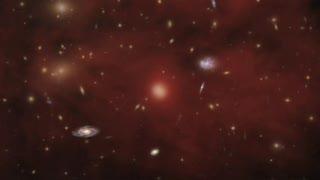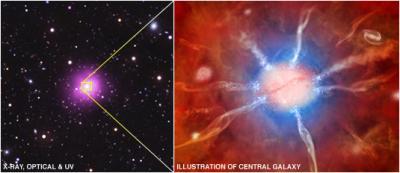"We thought that these very deep sounds might be found in galaxy clusters everywhere," said co-author Ryan Foley, a Clay Fellow at the Harvard-Smithsonian Center for Astrophysics in Cambridge, Mass. "The Phoenix cluster is showing us this is not the case -- or at least there are times the music essentially stops. Jets from the giant black hole at the center of a cluster are apparently not powerful enough to prevent the cluster gas from cooling."
With its black hole not producing powerful enough jets, the center of the Phoenix cluster is buzzing with stars that are forming about 20 times faster than in the Perseus cluster. This rate is the highest seen in the center of a galaxy cluster but not the highest seen anywhere in the universe. However, other areas with the highest star formation rates, located outside clusters, have rates only about twice as high.
The frenetic pace of star birth and cooling of gas in the Phoenix cluster are causing the galaxy and the black hole to add mass very quickly -- an important phase the researchers predict will be relatively short-lived.
"The galaxy and its black hole are undergoing unsustainable growth," said co-author Bradford Benson, of the University of Chicago. "This growth spurt can't last longer than about a hundred million years. Otherwise, the galaxy and black hole would become much bigger than their counterparts in the nearby universe."
Remarkably, the Phoenix cluster and its central galaxy and supermassive black hole are already among the most massive known objects of their type. Because of their tremendous size, galaxy clusters are crucial objects for studying cosmology and galaxy evolution, so finding one with such extreme properties like the Phoenix cluster is important.
"This spectacular star burst is a very significant discovery because it suggests we have to rethink how the massive galaxies in the centers of clusters grow," said Martin Rees of Cambridge University, a world-renowned expert on cosmology who was not involved with the study. "The cooling of hot gas might be a much more important source of stars than previously thought."
The Phoenix cluster originally was detected by the National Science Foundation's South Pole Telescope, and later was observed in optical light by the Gemini Observatory, the Blanco 4-meter telescope and Magellan telescope, all in Chile. The hot gas and its rate of cooling were estimated from Chandra data. To measure the star formation rate in the Phoenix cluster, several space-based telescopes were used, including NASA's Wide-field Infrared Survey Explorer and Galaxy Evolution Explorer and ESA's Herschel.

This animation shows how large numbers of stars form in the Phoenix Cluster. It begins by showing several galaxies in the cluster and hot gas (in red). This hot gas contains more normal matter than all of the galaxies in the cluster combined, and can only be detected with X-ray telescopes like Chandra. The camera then flies in towards the large elliptical galaxy at the center of the cluster. The hot gas near this galaxy is giving off copious amounts of X-rays and cooling quickly over time, as shown by the change to a blue color. This cooling causes gas to flow inwards along filaments and form huge numbers of stars when it continues to cool.
(Photo Credit: NASA/CXC/A. Hobart)

The Phoenix Cluster is an extraordinary galaxy cluster that is breaking several important astronomical records. The composite image on the left includes an X-ray image from Chandra (purple), an optical image from the 4-meter Blanco telescope (red, green and blue), and an ultraviolet image from GALEX (blue). This galaxy cluster has been dubbed the "Phoenix Cluster" because of the constellation in which it is found, and because of its remarkable properties including an exceptionally high rate of star formation in its center. The artist's illustration on the right depicts the cluster's central galaxy surrounded by hotter (red) and cooler gas (blue). Flowing gas is shown in the ribbon-like structures, and the newly formed stars appear as smaller blue and white dots.
(Photo Credit: X-ray: NASA/CXC/MIT/M.McDonald; UV: NASA/JPL-Caltech/M.McDonald; Optical: AURA/NOAO/CTIO/MIT/M.McDonald; Illustration: NASA/CXC/M.Weiss)
Source: Chandra X-ray Center